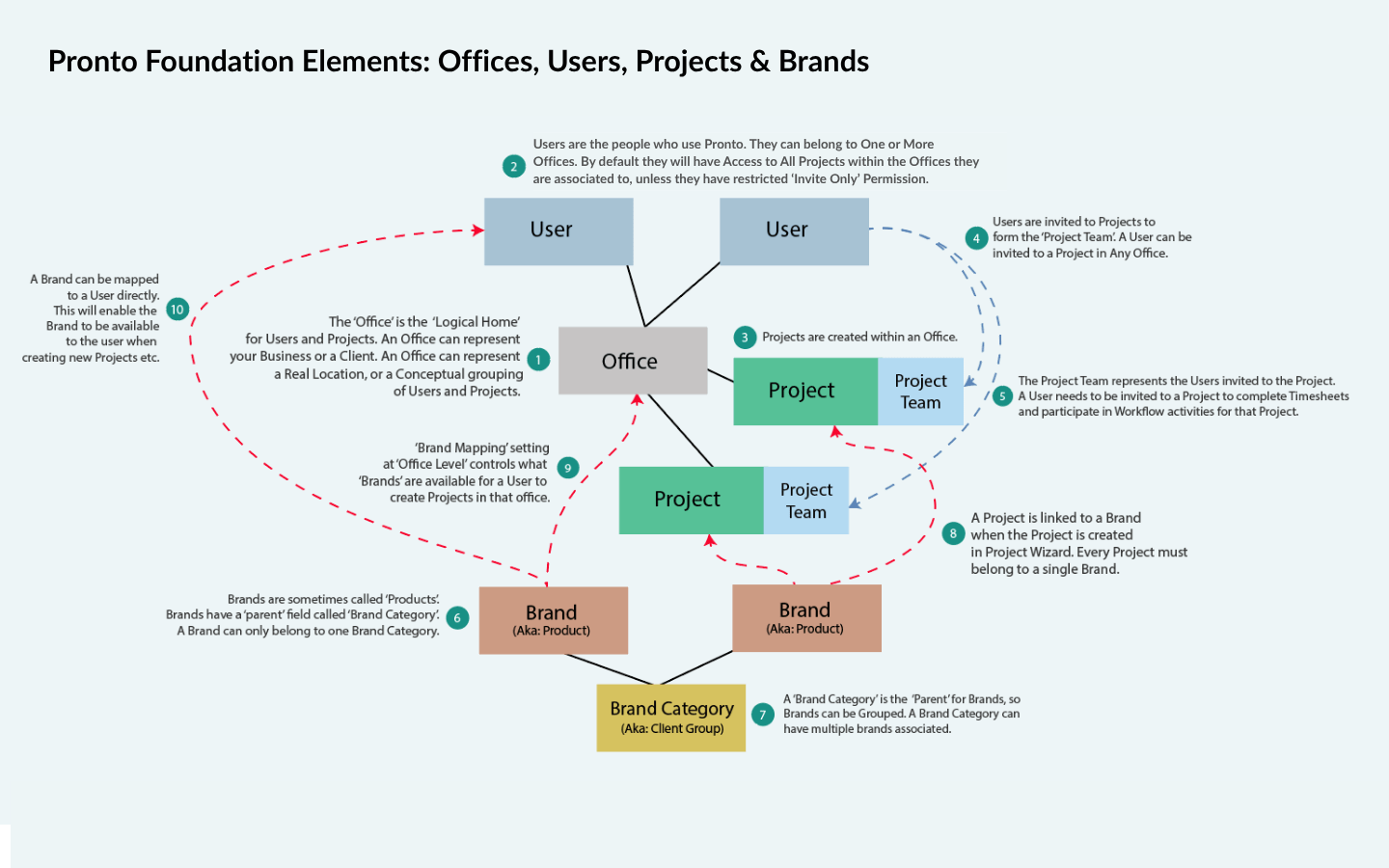In Pronto, the concept of a Brand is central to how projects are tracked, organised, and secured — especially within the Asset Library.
What is a Brand?
A Brand in Pronto acts as a layer of Project MetaData, similar to a Client or Customer — but more precise.
Why?
Because a single client often has multiple brands, and each brand may require its own projects, assets, and reporting.
Example structure:
Master Client: Coca-Cola
Brands: Coke Classic, Coke Zero, Diet Coke, Coke Stevia
Projects are linked to specific Brands, and Brands are grouped under Master Clients for roll-up reporting and organisational clarity.
Why?
Because a single client often has multiple brands, and each brand may require its own projects, assets, and reporting.
Example structure:
Master Client: Coca-Cola
Brands: Coke Classic, Coke Zero, Diet Coke, Coke Stevia
Projects are linked to specific Brands, and Brands are grouped under Master Clients for roll-up reporting and organisational clarity.
Is ‘Brand’ the same as a ‘Client’ & ‘Customer’?
Not quite — and here’s why it matters.
In Pronto, a Brand is linked to a Client Office, but it’s not the same as the Client or Customer itself.
This separation exists because Pronto is a global system — and we need to support scenarios where the same Brand is managed across different Client Offices in different countries.
Why it works this way:
Client Offices represent the billable entity in the finance system (linked to invoicing, tax settings, and finance approvals)
Brands represent the strategic identity for the work — often shared across regions
Keeping them separate allows us to:
Run projects for the same Brand in multiple countries
Maintain clean reporting and finance separation
Accurately map offices, users, billable customers, and brands
Example:
Billable Customer (USA): Coca-Cola USA
Billable Customer (UK): Coca-Cola UK
Both produce projects for the Brand: Coke Zero
This setup ensures consistent Brand tracking and secure cross-office collaboration, while maintaining proper billing separation.
In Pronto, a Brand is linked to a Client Office, but it’s not the same as the Client or Customer itself.
This separation exists because Pronto is a global system — and we need to support scenarios where the same Brand is managed across different Client Offices in different countries.
Why it works this way:
Client Offices represent the billable entity in the finance system (linked to invoicing, tax settings, and finance approvals)
Brands represent the strategic identity for the work — often shared across regions
Keeping them separate allows us to:
Run projects for the same Brand in multiple countries
Maintain clean reporting and finance separation
Accurately map offices, users, billable customers, and brands
Example:
Billable Customer (USA): Coca-Cola USA
Billable Customer (UK): Coca-Cola UK
Both produce projects for the Brand: Coke Zero
This setup ensures consistent Brand tracking and secure cross-office collaboration, while maintaining proper billing separation.
What do ‘Brands’ Do in Pronto?
Brands in Pronto are more than labels — they shape access, control visibility, and power your reporting tools.
1. Document access in the Asset Library
When a User is mapped to a Brand, they can access Documents tagged with that Brand — only if the files are marked as Approved for Release.
This ensures:
Controlled access to final assets
Easy brand-based visibility for the right users
Clean handoff to clients or regional teams
2. Brand filters in reporting tools
Brand metadata powers filters across all major reporting tools in Pronto — including reports on:
Projects
Tasks
Files
Timesheets
Finances
If a user is mapped to a Brand (via Brand–User or Brand–Office), they’ll be able to filter reports by that Brand or its Master Client group.
Important note:
Brand access ≠ project access.
Mapping a user to a Brand:
Does not give access to all Projects under that Brand
Does not override standard Project Access Levels
It only enables access to Brand-level filters in reports — not to project data itself.
1. Document access in the Asset Library
When a User is mapped to a Brand, they can access Documents tagged with that Brand — only if the files are marked as Approved for Release.
This ensures:
Controlled access to final assets
Easy brand-based visibility for the right users
Clean handoff to clients or regional teams
2. Brand filters in reporting tools
Brand metadata powers filters across all major reporting tools in Pronto — including reports on:
Projects
Tasks
Files
Timesheets
Finances
If a user is mapped to a Brand (via Brand–User or Brand–Office), they’ll be able to filter reports by that Brand or its Master Client group.
Important note:
Brand access ≠ project access.
Mapping a user to a Brand:
Does not give access to all Projects under that Brand
Does not override standard Project Access Levels
It only enables access to Brand-level filters in reports — not to project data itself.
How to apply brands in Pronto
Brands are assigned to Projects during setup — primarily via the Project Wizard. This helps drive consistent reporting, asset control, and brand-level visibility.
How it works:
- Assign a Brand in the Project Wizard
When creating a new Project, select the relevant Brand to link it. This ensures accurate tracking and reporting. - Map Brands to Offices
A Brand must be mapped to an Office to be available for users in that office during project setup. - (Optional) Map Brands to individual Users
This gives selected users access to a Brand without opening it to the entire office. Ideal when just a few people manage the brand.


